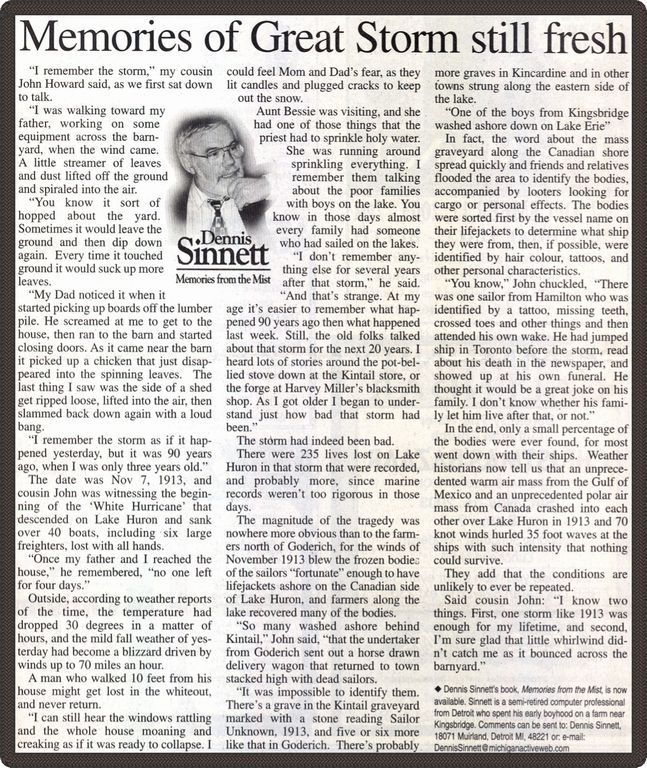Newspaper article

Date: November 2003
Credits: Goderich Signal Star
Memories of Great Storm still fresh
By Dennis Sinnett
“I remember the storm,” my cousin John Howard said, as we first sat down to talk.
“I was walking toward my father, working on some equipment across the barnyard, when the wind came. A little streamer of leaves and dust lifted off the ground and spiraled into the air. You know it sort of hopped about the yard. Sometimes it would leave the ground then dip down again. Every time it touched ground it would suck up more leaves. My Dad noticed it when it started picking up boards off the lumber pile. He screamed at me to get to the house, then ran to the barn and started closing doors. As it came near the barn it picked up a chicken that just disappeared into the spinning leaves. The last thing I saw was the side of a shed get ripped loose, lifted into the air, then slammed back down again with a loud bang. I remember the storm as if it happened yesterday, but it was 90 years ago, when I was only three years old.”
The date was Nov 7, 1913, and cousin John was witnessing the beginning of the ‘White Hurricane’ that descended on Lake Huron and sank over 40 boats, including six large freighters, lost with all hands.
“Once my father and I reached the house,” he remembered, “no one left for four days.”
Outside, according to weather reports of the time, the temperature had dropped 30 degrees in a matter of hours, and the mild fall weather of yesterday had become a blizzard driven by winds up to 70 miles an hour. A man who walked 10 feet from his house might get lost in the whiteout, and never return.
“I can still hear the windows rattling and the whole house moaning and creaking as if it was ready to collapse. I could feel Mom and Dad’s fear, as they lit candles and plugged cracks to keep out the snow. Aunt Bessie was visiting, and she had one of those things that the priest had to sprinkle holy water. She was running around sprinkling everything. I remember them talking about the poor families with boys on the lake. You know in those days almost every family had someone who had sailed on the lakes. I don’t remember anything else for several years after that storm,” he said.
“And that’s strange. At my age it’s easier to remember what happened 90 years ago then what happened last week. Still, the old folks talked about that storm for the next 20 years. I heard lots of stories around the pot-bellied stove down at the Kintail store, or the forge at Harvey Miller’s blacksmith shop. As I got older I began to understand just how bad that storm had been.”
The storm had indeed been bad.
There were 235 lives lost on Lake Huron in that storm that were recorded, and probably more, since marine records weren’t too rigorous in those days.
The magnitude of the tragedy was nowhere more obvious than to the farmers north of Goderich, for the winds of November 1913 blew the frozen bodies of the sailors “fortunate” enough to have lifejackets ashore on the Canadian side of Lake Huron, and farmers along the lake recovered many of the bodies.
“So many washed ashore behind Kintail,” John said, “that the undertaker from Goderich sent out a horse drawn delivery wagon that returned to town stacked high with dead sailors. It was impossible to identify them. There’s a grave in the Kintail graveyard marked with a stone reading Unknown Sailor, 1913, and five or six more like that in Goderich. There’s probably more graves in Kincardine and in other towns strung along the eastern side of the lake. One of the boys from Kingsbridge washed ashore down on Lake Erie.”
In fact, the word about the mass graveyard along the Canadian shore spread quickly and friends and relatives flooded the area to identify the bodies, accompanied by looters looking for cargo and personal effects. The bodies were sorted first by the vessel name on the lifejackets to determine what ship they were from, then, if possible, were identified by hair colour, tattoos, and other personal characteristics.
“You know,” John chuckled, “There was one sailor from Hamilton who was identified by a tattoo, missing teeth, crossed toes and other things and then attended his own wake. He had jumped ship in Toronto before the storm, read about his death in the newspaper, and showed up at his own funeral. He thought it would a great joke on his family. I don’t know whether his family let him live after that, or not.”
In the end, only a small percentage of the bodies were ever found, for most went down with their ships. Weather historians now tell us that an unprecedented warm air mass from the Gulf of Mexico and an unprecedented polar air mass from Canada crashed into each other over Lake Huron in 1913 and 70 knot winds hurled 35-foot waves at the ships with such intensity that nothing could survive.
They add that the conditions are unlikely to ever be repeated.
Said cousin John: “I know two things. First, one storm like 1913 was enough for my lifetime, and second, I’m sure glad that little whirlwind didn’t catch me as it bounced across the barnyard.”

